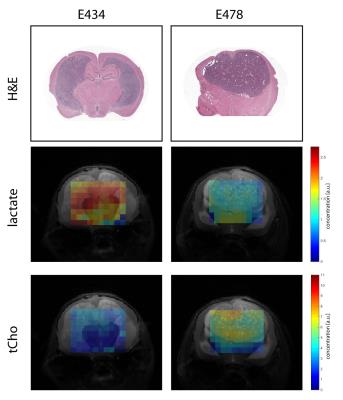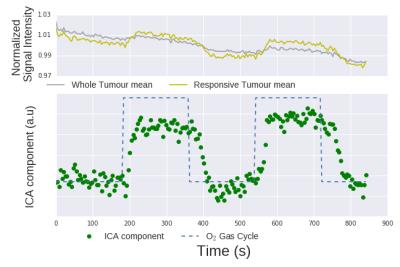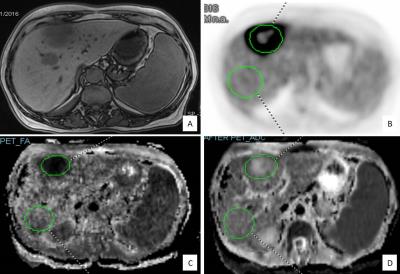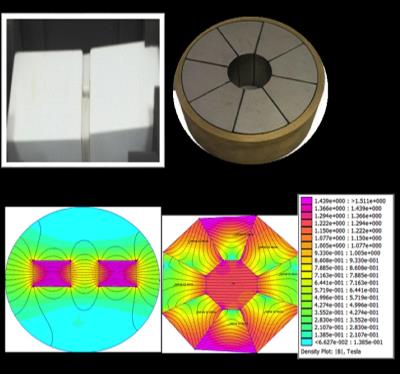Cancer Treatment Response
Electronic Poster
General Cancer Imaging
Tuesday, 25 April 2017
| Exhibition Hall |
16:15 - 17:15 |
| |
|
Computer # |
|
4351.
|
1 |
A multi-parametric MRI-based radiomics approach to predict the high level of microsatellite instability in colorectal cancer 
Zaiyi Liu, Yanqi Huang, Xin Chen, Zhongping Zhang, Lan He, Xiaomei Huang
Microsatellite instability (MSI) is the condition of genetic hypermutability that results from impaired DNA mismatch repair (MMR). High levels of microsatellite instability (MSI-H) is regarded as a prognostic marker and predictor of the response to chemotherapy in colorectal cancer (CRC). This study presented a multi-parametric radionics classifier for preoperative and individualized prediction of MSC-H status in CRC patients. The potential application of this radiomics approach may aid the prognostic evaluation and decision-making in CRC patients.
|
|
4352.
 |
2 |
Magnetic Resonance Spectroscopic Early Predictors of 2-Year Progression Free Survival in IDH Mutated WHO II and III Gliomas 
Min Zhou, Raymond Huang, Huijun Liao, Benjamin Rowland, Yue Zhou, Nils Arvold, Alexander Lin
Most MR spectroscopy studies of patients with IDH-mutated gliomas have focused on the sensitivity and specificity of the 2-hydroxyglutarate measures but none that have examined the predictive value of 2HG in comparison to other brain metabolites for treatment outcome. This prospective longitudinal study measured MRS at baseline and two time points after radio/chemotherapy of IDH-mutated gliomas. Results showed that Cho/NAA shows the greatest predictive value followed by Cho/Cr, NAA/Cr, and Lac/Cr ratios but that all three time points 2HG levels were not predictive of outcome demonstrating that it is likely reflective of pathways distinct from membrane proliferation.
|
|
4353.
 |
3 |
Radiation-induced changes in normal-appearing brain in patients with nasopharyngeal carcinoma: a MR T1? imaging study 
Xiang Xiao, Yikai Xu, Yuankui Wu, Yingjie Mei, Queenie Chan
Radiation encephalopathy is the primary complication in patients with nasopharyngeal carcinoma (NPC) following radiotherapy (RT). In order to detect early radiation-induced alterations in the brain of NPC patients after RT, we recruited NPC patients before RT and after RT with normal-appearing brain for MR T1ρ examinations. We found abnormal microstructural changes of gray matter and white matter in NPC patients after RT can be detected by MR T1ρ even when routine MRI findings are negative. MR T1ρ may be used to predict early radiation-induced alterations of the brain following RT for NPC patients.
|
|
4354.
 |
4 |
Using MRI to investigate the impact of radiation-induced damage on promoting tumor growth in a mouse model of brain metastasis 
Amanda Hamilton, Eugene Wong, Paula Foster
Whole brain radiotherapy (RT) is the standard of care for breast cancer patients with multiple brain metastases but there are multiple negative consequences associated with the irradiation of normal brain tissue. In our study we investigated the influence that RT-induced damage of healthy brain has on the arrest and growth of metastatic breast cancer cells in a mouse model of breast cancer brain metastasis. We observed that irradiated but otherwise healthy neural tissue had an increased propensity to support metastatic growth compared to control. Elucidating the impact of RT on normal neural tissue could have implications in clinical patient management.
|
|
4355.
 |
5 |
Quantitative assessment of water diffusivity in bladder tumors: can response be predicted prior to neoadjuvant chemotherapy? 
Huyen Nguyen, Amir Mortazavi, Kamal Pohar, Lai Wei, Zarine Shah, Debra Zynger, Guang Jia, Michael Knopp
This study is to correlate the degree of tumor heterogeneity in Apparent Diffusion Coefficient (ADC) at baseline with chemotherapeutic response in bladder cancer patients. MRIs of twenty muscle-invasive bladder cancer patients were performed with Diffusion weighted MRI (DWI). Freehand ROIs were placed on the whole tumor volume on ADC maps to obtain a dataset of voxel-wise ADC values for each patient. Histogram analysis was performed on each patient’s ADC dataset to calculate uniformity (U) and entropy (E) at baseline. These quantities were then correlated with the patient’s chemotherapeutic response. Our data showed that there was a strong correlation of tumor heterogeneity, which is characterized by U and E, and the patient’s chemotherapeutic response. While U was significantly higher, E was significantly lower in responders (both P<0.01) compared to non-responders. In conclusion, quantification of tumor ADC heterogeneity can provide useful information that enables the ability to predict chemotherapeutic response prior to the treatment, to improve the patient outcomes.
|
|
4356.
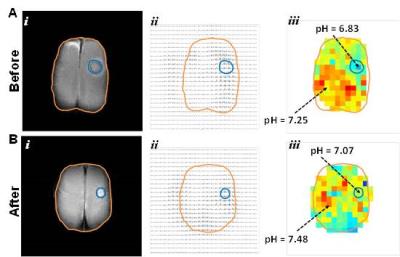 |
6 |
Simultaneous imaging of tumor size with contrast-enhanced MRI and response to therapy with extracellular pH readout from BIRDS 
Jyotsna Upendra Rao, John Walsh, Maxime Parent, Yuegao Huang, Meser Ali, Daniel Coman, Fahmeed Hyder
Acidic extracellular pH (pHe) of gliomas promotes tumor growth and builds resistance to therapy. Thus, to monitor therapeutic response, we used Biosensor Imaging of Redundant Deviation in Shifts (BIRDS), to generate pHe maps of rat brains bearing U251 tumors. Upon TmDOTP5- infusion, MRI identified tumor boundary and BIRDS imaged the intratumoral and peritumoral pHe gradient (DpHe). Two weeks post implantation of U251 glioma cells, animals were either treated with temozolomide (40 mg/kg) or were left untreated. The results of both terminal and longitudinal studies suggest that temozolomide therapy hinders tumor growth and normalizes intratumoral pHe.
|
|
4357.
 |
7 |
Anatomical sites’ dependency of 3.0 T whole-body MRI’s signal fat fraction and apparent diffusion coefficient in multiple myeloma focal lesions 
Arash Latifoltojar, Margaret Hall-Craggs, Alan Bainbridge, Neil Rabin, Rakesh Popat, Ali Rismani, Kwee Yong, Shonit Punwani
The increasing utility of MRI's quantitative imaging biomarkers for disease characterisation and response monitoring necessitates a better understanding of underlying pathophysiological changes. This might be more pertinent when heterogeneous organ such as skeletal system is being investigated. In this work, we carry out a study into the heterogeneity of multiple myeloma's focal lesions on the basis of the various anatomical locations in skeleton.
|
|
4358.
 |
8 |
HCC treated with 90Yttrium radioembolization: can pre-treatment and 6week post-treatment volumetric ADC histogram measurements predict subsequent tumor response? 
Sonja Gordic, Mathilde Wagner, Riccardo Zanato, Stefanie Hectors, Cecilia Besa, Edward Kim, Bachir Taouli
We evaluated the potential of volumetric ADC histogram measurements (vADC) obtained pre- and 6 weeks (6w) post-treatment for prediction of HCC response to 90Yttrium radioembolization (RE). 22 patients underwent MRI at baseline and 6w after RE using a routine liver MRI protocol including DWI. Tumor response was assessed by mRECIST at 6 months post treatment. vADC mean, median and mode obtained at 6w post-treatment were significantly different between patients with partial/complete response vs. those with stable/progressive disease, and were a significant predictor of complete tumor response at 6 months, with vADC mode performing best. Pre-treatment vADC did not have any predictive value for response.
|
|
4359.
 |
9 |
Evaluation of HCC Response to Loco-regional Therapy: Validation of Response Criteria with MRI using Explant as a Reference 
Sonja Gordic, Idoia Corcuera-Solano, Ashley Stueck, Pamela Argiriadi, Preethi Guniganti, Michael King, Edward Kim, Swan Thung, Bachir Taouli
We assessed the performance of various imaging response criteria for the prediction of complete pathologic necrosis (CPN) of hepatocellular carcinoma post locoregional therapy on liver explant. Patients who underwent liver transplantation after locoregional therapy were included in this retrospective study. All patients underwent MRI using routine liver protocol within 90 days of liver transplant. RECIST, mRECIST, EASL, percentage of necrosis on subtraction images, and DWI (signal intensity and ADC) were assessed. CPN was retrospectively assessed in all tumors at histopathology. mRECIST, EASL, percentage of necrosis and signal intensity on DWI were all significant predictors of CPN while RECIST and ADC criteria were not.
|
|
4361.
 |
11 |
in vivo detection of tumor response to radiotherapy using Imaging Micro-structural Parameters Using Limited Spectrally Edited Diffsuion 
xiaoyu jiang, hua li, zou yue, junzhong xu, john Gore
The changes that occur over a cell cycle play a vital role in mediating a cell’s sensitivity towards radiation therapy. Radiation exposure is expected to arrest cells at a particular cell cycle phase which improves the effectiveness of subsequent doses of radiation/chemotherapy. Cells in different phases have different sizes that can be detected by diffusion MRI with appropriate diffusion times. In this study, we evaluate the hypothesis in a rat glioma model that measurements of mean tumor cell size provides a means to quantify changes of cell phase distributions, and hence is capable of monitoring tumor response to radiotherapy.
|
|
4362.
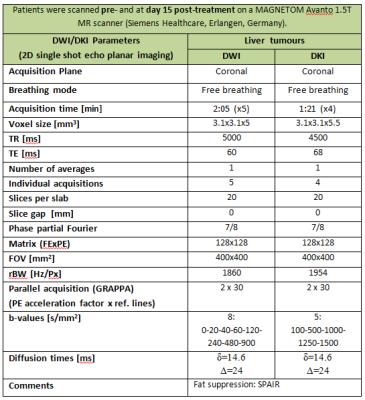 |
12 |
ADC and Kurtosis parameters show early response to anti-angiogenic therapy in patients with liver metastases - permission withheld
Mihaela Rata, Khurum Khan, David Collins, Matthew Orton, James d'Arcy, Nina Tunariu, Maria Bali, Ian Chau, Nicola Valeri, David Cunningham, Martin Leach, Dow-Mu Koh
Diffusion Weighted Imaging (DWI) is a valuable method of characterising tumour cellularity and assessing tumour response to therapy. Diffusion Kurtosis Imaging (DKI) is now being investigated outside of the brain, as the diffusional kurtosis metrics are strongly linked to cellular microstructure and heterogeneity in tissues. This work assesses tumour response to anti-angiogenic therapies as derived from DWI and DKI data in a cohort of patients with liver metastases enrolled on an early phase clinical trial. Our results demonstrate a significant cohort response to treatment of the ADC parameter, but also observed significant non-Gaussian diffusion behaviour.
|
|
4363.
 |
13 |
Impacting cancer cells via mechanical waves: can we change cellular behaviour? 
Marlies Hoelzl, Frederic Festy, Gilbert Fruhwirth, Ralph Sinkus
90% of cancer related deaths are caused by cancer metastasis, a process where cells leave the primary tumour, disseminate and form outgrowth at the secondary metastatic site. The tumour microenvironment provides crucial signals ((bio)chemical, mechanical) to regulate tumour formation, progression, and cell spread throughout the body. Translation of mechanical forces, displacements and deformations into biochemical signals (i.e. mechanotransduction) affects their cell behaviour (adhesion, spread, survival).1,2 We show here that multiple treatment of tumour spheroids (solid tumour model in vitro) with focussed shear waves operating at specific frequency and amplitude results in reduced growth and reduced invasive behaviour of cancer cells.
|
|
4365.
 |
15 |
Multiparametric MRI assessment of tumor physiological changes during hypofractionated SABR 
Heling Zhou, Zhang Zhang, Rebecca Denney, Jessica Williams, Jeni Gerberich, Strahinja Stojadinovic, Debabrata Saha, John Shelton, Ralph Mason
Hypofractionated stereotactic body radiation therapy, a new radiation treatment scheme, may be particularly susceptible to tumor hypoxia. We applied oxygen enhanced MRI together with DCE MRI to observe tumor physiological changes induced by a radiation fraction in a human lung cancer xenograft rat model. This study showed reduced vascular oxygenation 24 hours after the first fraction of 12 Gy, as indicated by the significant decrease in T2* compared to baseline, but no significant response in dynamic contrast enhanced MRI. DCE parametric maps revealed a multinodular structure in the tumor as confirmed by histology.
|
|
4366.
 |
16 |
Absence of oxygen enhanced changes in T2* within head and neck cancer metastatic cervical lymph nodes is associated with local disease recurrence within 2-years following chemoradiotherapy 
Harbir Sidhu, Chiara Tudisca, David Price, Sola Adeleke, Marianthi-Vasiliki Papoutsaki, Martin Forster, Ruheena Mendes, Stuart Taylor, Shonit Punwani
Hypoxia within head and neck squamous cell cancer metastatic lymph nodes is associated with poorer outcomes following chemoradiotherapy when measured directly using polarographic probes. The utility of non-invasive pretreatment T2* measurement in prediction of chemoradiotherapeutic response was investigated. Our data suggest, however, that nodes demonstrating sustained post-therapy complete local response based on two-year follow-up are significantly more hypoxic compared with relapsing-nodes and paradoxically demonstrate a significant increase in hypoxia on breathing 100%-oxygen.
Following further work to ascertain the mechanisms of these observed changes, the differential response to oxygen and lower baseline oxygenation in responding-nodes could be exploited in risk stratification.
|
|
4367.
 |
17 |
Prediction of Individual Breast Tumor Therapeutic Response 
Charles Springer, Jr., Xin Li, Megan Troxell, Karen Oh, Arpana Naik, Kathleen Kemmer, Aneela Afzal, May Mishal, Alina Tudorica, Wei Huang
Synopsis: A kio parametric image maps Na+,K+ATPase activity with intra-tumor resolution. For breast tumors, the kio hot spot fraction decreases after one NACT cycle if the tumor goes on to be cancer-free after NACT completion, but not if it maintains residual cancer. Also, though kio hot spots are reduced after one NACT cycle, new ones appear in different loci. This is consistent with metabolic competition between different cancer cell populations within the tumor.
|
|
4364.
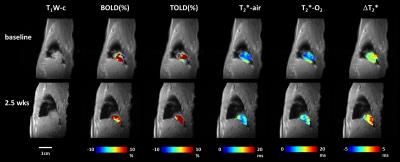 |
14 |
Evaluation of tumor oxygenation following radiation and PS-targeting antibody therapy in an orthotopic lung cancer model 
Heling Zhou, Olivier Belzile, Zhang Zhang, Debabrata Saha, Jo Wagner, Brock Sishc, Strahinja Stojadinovic, Rolf Brekken, Ralph Mason
Combining phosphatidylserine (PS)-targeting monoclonal antibodies with radiation therapy can potentially enhance treatment efficacy. Oxygenation is important in radiation therapy response and could influence future treatment design. Oxygen enhanced MRI was used to examine changes in oxygenation in orthotopic lung tumors in rats treated by radiation or radiation plus a PS-targeting antibody. Orthotopic tumors were well oxygenated and responsive to oxygen breathing challenges before and after treatment. Combination therapy appeared to be more effective in tumor control than radiation alone.
|
|
4368.
 |
18 |
In-vivo Detection of Acute Intracellular Acidification in Glioblastoma Multiforme by AACID CEST MRI Following a Single Dose of Cariporide and Quercetin 
Mohammed Albatany, Alex Li, Susan Meakin, Robert Bartha
Identification of tumor boundaries is challenging due to the infiltrative nature of the cancer. Cariporide and quercetin are drugs approved for human use that target different pH regulatory mechanisms in cancer. The goal of the current study is to determine whether chemical exchange saturation transfer (CEST) MRI is sensitive to tumor acidification after cariporide or quercetin injection. In mice with U87 glioblastoma brain tumors, we found both drugs significantly reduced tumor pH within two hours of treatment measured by CEST MRI. The physiological change induced by cariporide or quercetin could help localize brain cancer and monitor tumor response to chemotherapy. This unique approach to cancer detection does not require injection of an imaging contrast agent.
|
|
4360.
 |
10 |
Value of Tumor Stiffness Measured with MR Elastography for Assessment of Response of Hepatocellular Carcinoma to Locoregional Therapy 
Sonja Gordic, Jad Bou Ayache, Paul Kennedy , Cecilia Besa, Mathilde Wagner, Octavia Bane, Richard Ehman, Edward Kim, Bachir Taouli
We correlated tumor stiffness (TS) measured with MR elastography (MRE) to degree of tumor enhancement and necrosis on contrast-enhanced T1-weighted imaging (CE-T1WI) in hepatocellular carcinomas (HCC) treated with locoregional therapy. Patients with HCC who underwent locoregional treatment and controls with newly diagnosed untreated HCC were included. TS values were obtained by placing regions of interest (ROIs) over HCCs on stiffness maps. Visual assessment of tumor necrosis on subtraction images and calculation of enhancement ratios by placing ROIs over tumors on CE-T1WI was performed. TS measured with MRE showed a significant correlation with tumor enhancement and necrosis.
|
|
4369.
 |
19 |
The use of DCE MRI in predicting early chemo-radiotherapy treatment response for Larynx and hypopharynx carcinoma - permission withheld
Wei Guo, Dehong Luo, Xinyi Chen, Bing Wu, Meng Lin, Lin Li, Yanfeng Zhao, Xinming Zhao, Chunwu Zhou
In this work, we evaluated the utility of pretreatment semi-quantitative dynamic contrast-enhanced magnetic resonance imaging (MRI) in predicting early response to CRT (chemo-radiotherapy) in patients with larynx and hypopharynx carcinoma from primary tumors. To our knowledge, few studies correlate DCE-MRI semi-quantitative parameters on larynx and hypopharynx carcinoma. These quantitative methods do not require high computational power and were very suitable for clinical application.
|
|
4370.
 |
20 |
DCE-MRI Assessment of Breast Cancer Response to Neoadjuvant Chemotherapy: Early Prediction of Response and Evaluation of Residual Disease 
Alina Tudorica, Karen Oh, Kathleen Kemmer, Megan Troxell, Arpana Naik, Neda Jafarian, Yiyi Chen, Stephen Chui, Eric Goranson, Nicole Roy, Aneela Afzal, May Mishal, Megan Holtorf, Charles Springer, Xin Li, Wei Huang
DCE-MRI was performed on 47 breast cancer patients (49 primary tumors) before, during, and after neoadjuvant chemotherapy (NACT). DCE-MRI data were subjected to Tofts model (TM) and Shutter-Speed model (SSM) pharmacokinetic (PK) analysis. Imaging metrics and the corresponding percent changes were correlated with binary pathologic complete response (pCR) and non-pCR endpoints, as well as residual cancer burden (RCB) index values. By NACT midpoint, several DCE-MRI PK parameters and percent changes are good early predictors of pCR vs. non-pCR, while tumor size is a poor predictor. Both PK parameters and tumor size after NACT completion are good markers of RCB. TM and SSM parameters perform equally well for prediction of NACT response and evaluation of RCB.
|
|
4371.
 |
21 |
Near infrared photoimmunotherapy for lung cancer in a transgenic mouse model evaluated by MRI - permission withheld
Yuko Nakamura, Marcelino Bernardo, Zoe Ohler, Tadanobu Nagaya, Shuhei Okuyama, Fusa Ogata, Peter Choyke, Hisataka Kobayashi
Near infrared photoimmunotherapy (NIR-PIT) is a new cancer treatment that combines the specificity of antibodies for targeting tumors with the toxicity induced by photoabsorbers after irradiation with NIR light. The purpose of this study was to determine whether MRI can monitor the therapeutic effect of NIR-PIT in spontaneously occurring lung cancers that express epidermal growth factor receptor. Tumor volume ratio was inhibited significantly in the NIR-PIT group compared with control group. Thus, MRI can be a useful imaging modality for monitoring the therapeutic effects of NIR-PIT for cancer.
|
|
4372.
 |
22 |
Rapid MR Pancreatic and Ovarian Screening Imaging for Patients with BRCA Mutation Undergoing Screening Breast MRI – Pilot Study 
Sandra Huicochea Castellanos, Mitchell C. Raeside, Andrea Agostini, Richard K.G. Do, Amita Amita Shukla-Dava, David Aramburu Nunez, Ramesh Ramesh , Olga Smelianskaia, Monika Khan, Yuliya Lakhman, Evis Sala, Lorenzo Mannelli
The purpose of this study was to develop and optimize a rapid MR pancreas and ovarian screening protocol to be performed in conjunction with breast MRI screening in BRCA mutation carriers. Images were acquired with the patient in the prone position, with the breast coil still in place, but using the built-in body coil on a 3T magnet, and evaluated for image quality and detection of lesions. 30 women had research MR for pancreatic screening and 5 of them also underwent for rapid ovarian MR screening which provided diagnostic quality images within a short time of acquisition.
|
|
4373.
 |
23 |
Preoperative T Staging of Potentially Resectable Esophageal Cancer: 3T MRI based on T2-TSE-BLADE and contrast-enhanced free-breathing radial VIBE (StarVIBE) vs endoscopic ultrasound 
Jinrong Qu, Hongkai Zhang, Hui Liu, Xu Yan, Zhaoqi Wang, Hailiang Li, Kiefer Berthold, Nickel Marcel Dominik, Ihab R. Kamel
This study compared MRI based on the combination of T2-TSE-BLADE and contrast-enhanced T1 radial VIBE (StarVIBE) against endoscopic ultrasound (EUS) for T staging of potentially resectable esophageal cancer (EC). The histology confirmation of the T stage was used as reference. The results showed that the combination of T2-TSE-BLADE and StarVIBE is comparable to EUS in T staging of potentially resectable EC with lesions of T1/T2 stage, and is superior to EUS with lesions of T3/T4 stage.
|
|
4374.
 |
24 |
Appearance of Changes From Focal Therapy on Multiparametric Prostate Magnetic Resonance Imaging 
Daniel Margolis, Ely Felker, Shyam Natarajan, Chris Alabastro, Leonard Marks
Understanding the changes corresponding to focal therapy of prostate cancer on MRI is paramount to appropriate management, as serum tests may fail to accurately monitor these patients.
|
|

























































